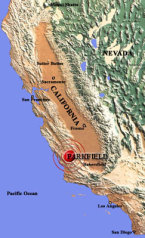Modeling Acts of God, Part 2 - Earthquakes
 Wednesday, July 11, 2007
Wednesday, July 11, 2007  This is #2 in a series. (Click here for #1 on modeling hurricanes)
This is #2 in a series. (Click here for #1 on modeling hurricanes)
Earthquake modeling seems to generate a wide range of emotions, vitriol, successes, and failures - so wide as to need a logarithmic scale, a la Richter.
The Parkfield Earthquake Experiment, now running for over 22 years, has been the development test bed and experimental "lab" for US Geological Survey/State of California efforts to develop physical models of earthquakes that will lead to viable predictions. The USGS site contains a wealth of information on the experiment, and good background on the history of earthquake prediction, which is still highly hit or miss. An interesting excerpt from the site neatly illuminates the need for prediction based on an understanding of physical causes as opposed to one based on statistical correlation only:
Early scientific efforts toward earthquake prediction in the U.S. were directed primarily toward the measurement of physical parameters in areas where earthquakes occur, including seismicity, crustal structure, heat flow, geomagnetism, electrical potential and conductivity, gas chemistry. Central to these efforts was the concept that a precursor might be observed in one or more of these measurements. However, the connection between a commonly accepted precursor and the earthquake was often speculative and uncertain. A coherent physical model was lacking.










